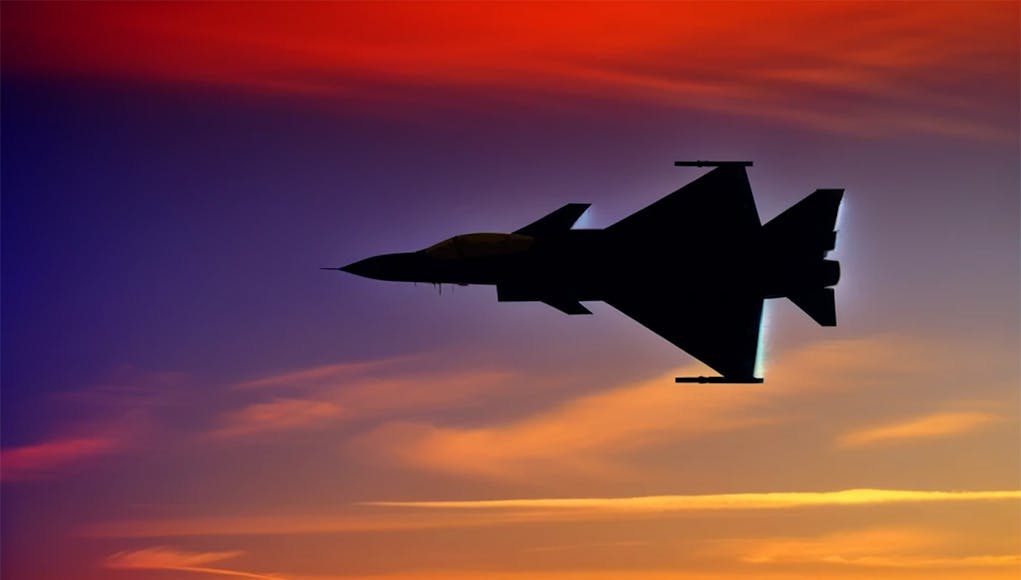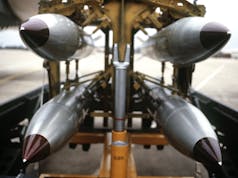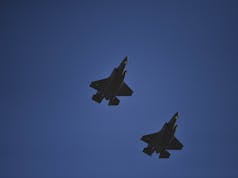Saab has received an order from the Swedish Defence Materiel Administration (FMV) regarding conceptual studies for future fighter systems. The contract period is 2024-2025.
This includes conceptual studies of manned and unmanned solutions in a system of system perspective, technology development and demonstrations.
Saab says here that it will collaborate closely with FMV, the Swedish Armed Forces, The Swedish Defence Research Agency, GKN Aerospace and other industry partners.
“Saab is in a strong position, and having recently developed Gripen E and GlobalEye we have the advanced technology and engineering know-how to take the future fighter concept forward. This means we will continue delivering innovative solutions to meet the future operational needs of the Swedish Armed Forces and other customers,” says Lars Tossman, head of Saab’s business area Aeronautics.
According to a news release from the firm:
“Saab will further develop collaborations with stakeholders working with emerging and disruptive technologies, which will play an important part in future combat aircraft systems. Saab will also explore innovation platforms including the Swedish Government’s Defense Innovation Initiative and NATO’s Defense Innovation Accelerator for the North Atlantic.”
The concept studies included in this contract will take place in parallel with Saab upgrading Gripen C/D and introducing Gripen E in Sweden and Brazil.














Surely it would make most sense to co-operate with the Bae consortium on Tempest? I mean Gripen was not a roaring commercial success which situation would have only benefited from volume?
yes.
They seem dead set on operating single engine fighter, which tempest isn’t.
Sweden’s need is based on their requirements, cost, location of operating platform etc. Single engine is cheaper than a twin engine, but also what is the doctrine that they are looking to use. There are pro’s and con’s for both single engine ans twin engine, but ultimately it will be down to cost and how the Swede’s will employ them.
Is F35 cheaper than a Twin engine d Aircraft of equivalent Spec then ?
F-22, yes.
No it certainly is not unless all other things are equal. As the F35 engine and indeed the Pegasus before it showed both are very costly to operate as both were complex ultra powerful engines to be able to give the required performance esp as dictated by the B model pushing the parameters. It was of course to be the cheap F16 replacement to accompany the expensive F15 replacing F22. Yes it’s technically cheaper than the F22 but only because the F22 was aiming for the stars and pushing almost unknown barriers and discovering them the hard way. If you accept the limitations of a single and don’t over stress it, as to be fair the Swedes do for perceived advantages in their own environment then yes it will be cheaper.
Personally though, I feel now that Sweden is in NATO that unique environment isn’t so important indeed is similar to Norway and Finland and thus being part of a bigger consortium I feel would thus be more beneficial overall bang for buck. An individual survival war against Russia isn’t really their reality any more. But you do have to admire their ability to extract great value and capability but in a 6th Gen environment? We shall see.
The F-22/F-35 cost ratio would have been much better had the F-22 production not been cut so early. An extra 200-300 (still well below the intended 800) would have lowered costs and as later production models would be even more suitable for upgrading. I always wondered what technology it had above and beyond the F-35 that restricted exports to willing customers like Japan and Australia.
I suspect they want light, cheap, able to operate from austere airfields. Not sure Tempest is a good fit for them.
Ian, would agree, their current tactics is ACE and has been for some considerable time. Small single engine A/C works well for the current set up.
Absolutely and it made sense as a sparsely populated but large mountainous Country expecting a surprise strike from its big enemy across the Baltic, particularly before the Baltics entered NATO. Only question is being part of a giant Alliance arguably changes the dynamics away from that priority and thus are they sticking to an out of date strategy. In reality I guess whatever they produce will be a match for any Russian competitor just wonder if going it alone gives them the best solution and enough of them for what it will cost, plus interoperability questions arise esp with Countries they will be expecting to work closely with now in NATO. Good luck to them mind.
They have gone beyond cheap with Gripen E costing $85m. Sweden’s problem is its small home market.. If the new design is even more expensive, it will be harder to market to other countries which still want (comparatively) low cost air defence capability.
Brazil has already bought into the Gripen E/F and will manufacture it locally.
I wonder to what extent Brazil will exploit it for their own future projects, it’s a Country with great ambitions.
The problem for their next aircraft is that it will have competitors from the likes of Turkey, South Korea, India perhaps and no doubt others so will they be able to export sufficiently while having a competitive solution for NATO needs?
While we make comparisons on where Gripen E sits within the Western capability tree, the reality is, it’s cheaper to procure, vastly cheaper to support and own, far more capable in real world terms, than anything Russia has.
By that I mean able to track, lock onto and kill any Russian fast jet, well before they are able to return the compliment.
They are able to carry a useful war load of modern ordnance, with a useful RoA.
What’s not to like quite frankly….
Sweden, though SAAB, is perfectly capable of designing and building a new airframe using modern 3d printing technology.
They could (probably will) transplant Gripen E technology and engine into the new airframe and have a very capable machine operational at a fraction of Tempests costs.
They will then introduce new technology into the airframe as it develops.
Gripen has been a great success,in terms of what it offers and what competition it is up against,and having pulled out of Tempest/GCAP it is obvious that Sweden is looking for a more ‘unique’ solution for its needs.I have put a link up which gives more information as and when it clears.
Thanks Paul. Meanwhile here in SA, our SAAF Gripens quietly deteriorate for lack of use and care under our useless government.
Tempest is going to be a lot more expensive, for starters.
I wish they would revise it so there was only a single production line for each component and a single final assembly line. Everyone can still have all the designs/etc
I know thats a non-starter for all involved but its what ramps up the costs so much.
Can you post a link to show what the cost’s of Tempest will be please ? Just interested in seeing some facts.
I have absolutely no idea, I don’t think its far enough along for tangible figures, but its a twin-engine 6th gen jet with a eurofighter style production style (for example each country making its own engines), I’ll eat my keyboard if its price competitive with a gripen replacement. The economies of scale are simply bad for 3 production lines & 3 engine plants.
Currently, Gripens are $85m, Eurofighters are $124m, F-35s went as low as $78m thanks to single-plant mass production, which tempest likely won’t ever see, but they started somewhere neat $178m
(figures pulled from google).
UK Committee of Public Accounts reported that mismanagement led to each aircraft costing 75% more than it should have, and I don’t expect those types of issues to be solved in Tempest, nor do i expect the MoD to place the kind of volume of orders needed to bring costs down. (source avail on wikipedia)
The F35B price for post 23 aircraft, including engine, is @$109m.
Well Gripens production line is unlikely to be bigger so the only way it will be cheaper is because it will be considerably less ambitious than Tempest. Japans requirement alone will dwarf Swedens and I doubt you can argue they will produce it less efficiently. Will Sweden produce more than Britain? Lots of ifs and buts but I suspect Britain isn’t trying to do it alone for good reason.
Japan needs its own production line, UK and Italy could share certainly but National pride will no doubt dictate. But still seems more practical than Sweden going it alone.
Swedes prove time and time again their particular needs are best met by producing their own without entanglements in multi national projects. Good luck to them.
Much of it comes from outside Sweden of course.
I do wonder why we always insist doing these programmes in collaboration with other countries when Sweden shows it is possible to go it alone. I don’t believe for a second Eurofighter was cheaper because four countries worked on it with all the duplication.
That said hopefully we can collaborate with them (and the Japanese and Italians) for components which could be shared: VCE engines and next gen radar. The airframe will be different for customers (Sweden wants single engine and smaller)
True that collaboration is rarely cheaper, however the Grifen successor is alot less ambitious than tempest
Exactly there’s a reason Countries haven’t gone to Sweden to help them design 5th let alone 6th Gen fighters other than their digital twinning technology anyway which is world leading,
It is complicated, to be sure. I kind of feel outside some of the larger US plane manufacturers many domestic companies simply lack the ability to do something on their own any more without significant investment to build the base required to operate an operation independently (not just the investment of the programme itself), even the Gripen is nowhere near a fully independent programme, as a lot of the components are not Sweden (about 30% are UK). Technically BAE/UK could do what Saab/Sweden did, make a UK only fighter and outsource (likely outside of the UK) what is needed to complete the jet, but all of the R&D would need to be footed by the MoD, meaning we will end up with a smaller project or a massive hole in our budget. This is compounded by limited initial orders and you may end up with a jet that does not sell, and if it does not sell the combined R&D and unit cost calculation makes per jet prices very uneconomical. The French did alright with Rafale but it is not a sure bet. Outside of the project itself, it is an opportunity to gain closer ties with other countries, and the diplomatic and political benefits must not be undersold. Plus if you make something with another country you can cross-sell weapons and future upgrades.
Britain is probably the only country other than the US which could make a 5/6th Gen fighter. Whilst people will point to the Russians and Chinese, they are a long way behind us in terms of engine technology (and we still maintain a tangible lead over the French). We also have the knowledge of stealth from
being a Tier 1 partner / BAe Replica etc.
Aerospace remains a strong export industry for Britain where we hover around 2nd or 3rd despite complete disinterest from the government…. A 5th/6th gen fighter programme would ensure our aerospace industry remains one of the best and second only to the US as well as enable us to avoid all the issues we have had with slow weapons integration for the F35
Perhaps there will be scope for collaboration on all the bits that make an airplane.
Even operating 2 planes sharing systems, engines, power management, weapons.
If tempest turns into an aircraft that requires lots of special equipment at a main big runway base, having a 2nd type that can do a lot of roles but operate from small locations easily would be desirable.
I would go as far to suggest that tempest be 2 manned jet for drone control and all the other jobs. The Swedish jet fitting nicely into a lighter single pilot role.
What is the big unknown is the loyal wingman. Will it work? How good will it be and how easy to control etc. without that knowledge it’s hard to know what workload the future jets will have.
Damn it MonkeyS. ! :), I was drafting something along the same lines. . .CAPTOR-E Mk.2 (the RAF, maybe Luftwaffe version) is based on a fusion of the Grippen-E’s systems with BAE’s. Perhaps SaaB wont be in the UK-IT-JP alliance (their loss, but anyway), but that doesn’t mean there cant be knowledge/tech. exchange, easier now SaaB is now a de ‘facto weapon corp. within NATO.
It’s funny how things can change in the space of 2 years. Sweden pulled out “officially” from the FCAS program in 2022. As I believe the proposed concept didn’t meet their requirements.
At the time Sweden was still a neutral Country and had specific requirements for its fighter aircraft. Namely the ability to operate and be replenished on Sweden’s minor roads. Therefore the aircraft needs to have a good short take off and landing (STOL) performance. Which goes hand in hand with good maneuverability and power to weight.
I don’t believe the FCAS program meets these requirements. For starters to maintain stealthiness, the weapons need to be carried internally. You will need lots of them. Plus to overmatch your opponent in an air to air fight, they need be faster and longer ranged. Therefore the weapons bays will need to be large. Additionally, the aircraft’s duration is required to be better than existing platforms. So it needs to carry more fuel. If the aircraft is controlling loyal wingman, that scout ahead and maybe carry some weapons. Does the aircraft need to be hyper-agile. As not only does the wingman do this job and can be sacrificed if needed. But missiles such as ASRAAM negate the need for dogfighting.
Therefore the aircraft can be better tailored for long range efficiency. But due to weapons configuration and load out. It will need to be big, much bigger than Typhoon or the F22 to meet this requirement. Much like a stealthy version of the Tornado F3. A long range missile carrying inderdictor. Which negates a STOL capability, hence Sweden’s leaving the project.
But Sweden has now joined NATO due to Russia’s war in Ukraine and its threat to the wider European countries. Will that mean they rejoin FCAS? I’m not so sure as it will require a complete doctrinal and infrastructure change. So perhaps they may buy into the systems and avionics part. But put into a locally produced aircraft, that better suits there needs.
I think somewhere between yours and Monkey’s comment probably lays the answer.
I have a mild suspicion that Sweden will take a larger participation in Tempest but not as a partner more of a technology and components partner.
At the same time airfields are easily targeted, should we be looking at an airframe that can operate from roads and other lesser prepared airfields. I wonder if you might see something like Aeralis but again more of a parts/software commonality/interchangeability, over modular structure and engines.